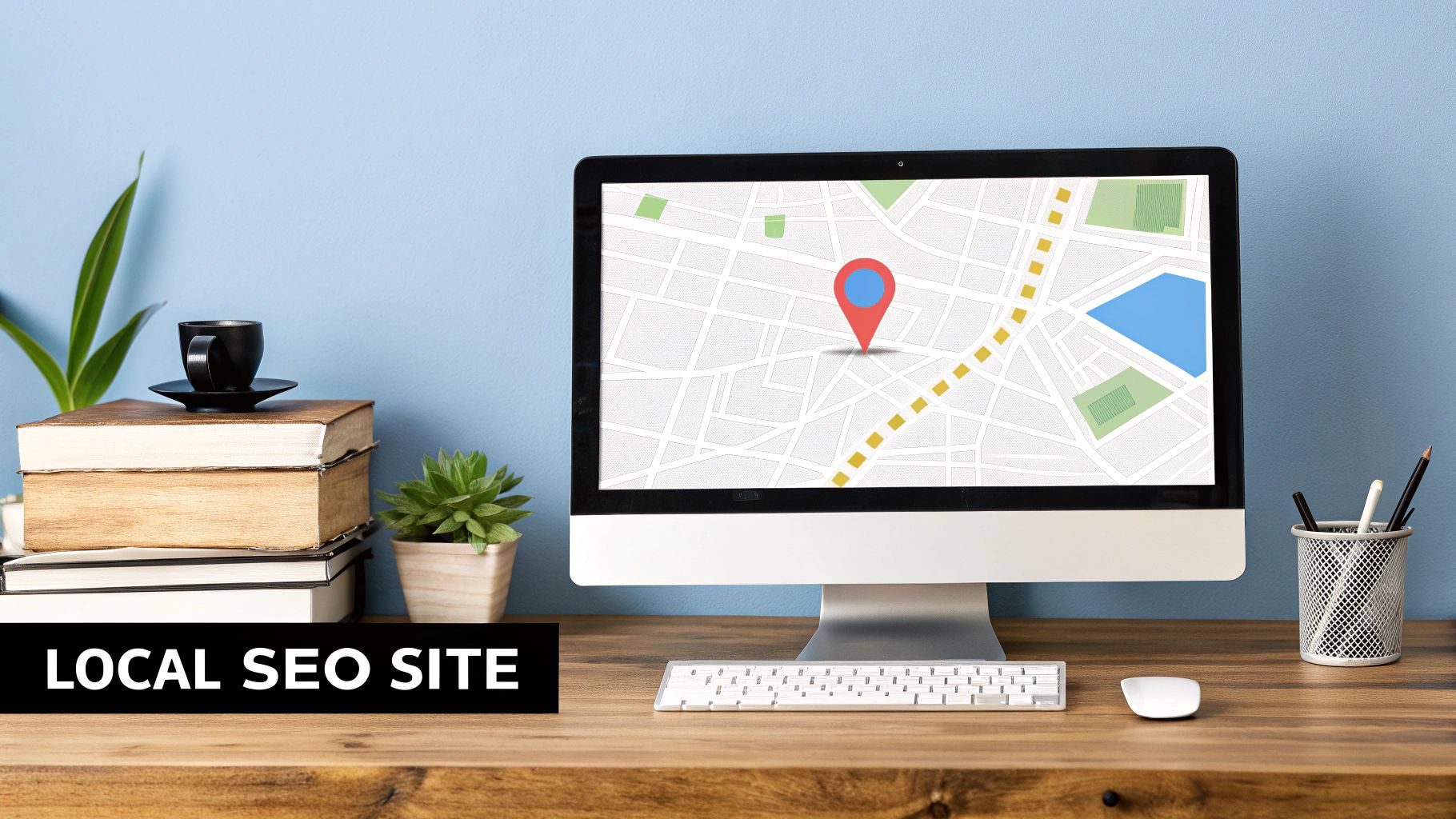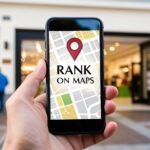Want to rank higher on Google Maps? Think of your Google Business Profile as a live marketing tool, not just a static listing.
When you consistently feed it fresh information, get positive reviews, and keep your business details accurate across the web, you send strong signals to Google. You're telling the algorithm you're a relevant, trustworthy choice for local customers.
Why Ranking Higher on Google Maps Matters
Ranking high on Google Maps isn't just for show. It's about being the first answer when someone nearby searches for "plumber near me" or "best coffee shop."
Landing in the local 3-pack leads directly to more foot traffic, phone calls, and business. It's like digital curb appeal—a polished, visible profile builds instant trust.
This is one of the most powerful local marketing strategies because it puts your business right where people are making buying decisions.
What does Google Maps ranking do for a business?
The data shows that visibility on Google Maps has a huge impact.
A stunning 86% of people use Google Maps to find local businesses. More than half of them choose from the top 5 results they see.
Plus, customers are 2.7 times more likely to consider a business trustworthy if they find a complete and active profile. It's an instant credibility boost.
In Short: A high Google Maps ranking is a direct reflection of your local authority. It’s the difference between being the go-to choice and being completely overlooked.
To get a better idea, here are the core components that influence your Google Maps ranking. We'll cover each one in this guide.
Core Pillars for Ranking Higher on Google Maps
| Pillar | What It Means for You | Why It Matters |
|---|---|---|
| Profile Optimization | Filling out every single section of your GBP with rich, accurate info. | A complete profile is seen as more trustworthy by Google and users alike. |
| Reputation & Reviews | Actively gathering and responding to customer reviews. | Social proof is huge. Positive reviews tell new customers you're a safe bet. |
| Local Citations & Links | Getting your business name, address, and phone number listed on other relevant sites. | Consistency across the web proves to Google that your business is legitimate and established. |
| On-Site Local SEO | Tying your website content back to your local service area and offerings. | It connects the dots for Google, reinforcing your local authority on and off your profile. |
This isn't just about tweaking one thing. It’s part of a bigger puzzle. To really see results, you need to understand what local SEO marketing entails.
Building local citations, optimizing your website, and managing your reputation all feed into your Maps presence. This holistic approach is what truly moves the needle. Our guide on local SEO services for small businesses is all about creating a unified strategy that drives real growth.
How to Optimize Your Google Business Profile for Better Rankings
Your Google Business Profile (GBP) is the foundation of your Google Maps visibility. A complete profile is a powerful signal to Google that you're a legitimate, active, and relevant local business.
If you want to rank higher on Google maps, filling in just the basics won't be enough.
Think of your GBP as your digital storefront. It's often the first interaction a potential customer has with your business, so make it count.
Nail Your Business Categories
This is one of the most critical parts of your GBP setup. Your categories tell Google what you do and which customers to show your profile to.
- Primary Category: Be as specific as possible. This should be the single best description of your core business. If you're a plumber who also does HVAC work, your primary category should be "Plumber."
- Secondary Categories: Add other relevant services here. The same plumber could add "HVAC contractor" or "Drain cleaning service." Add as many as are truly relevant.
Getting your categories right helps you show up for "discovery" searches, like when someone types in "plumber near me" instead of your business name.
Write a Helpful Business Description
You have 750 characters for your business description. Use it to explain what makes you the best choice while naturally including keywords.
A great description should:
- Lead with your value: Start with what you do best and for whom.
- Use keywords naturally: Mention your main services and the areas you serve. For example, "Your trusted local plumber for emergency repairs and new installations throughout the Springfield area."
- Show what makes you different: Mention if you have 20 years of experience or are family-owned.
In Short: Never stuff keywords into your business name (like "Springfield Plumbing – Best Plumbers"). This is against Google's guidelines and can get your profile suspended. Keep your business name exactly as it appears on your signage.
A strong profile builds trust with customers and Google, which boosts your ranking potential.
Keep Your Core Info Consistent
For Google, consistency is key. Different information on various websites creates confusion and erodes trust, which can hurt your rankings.
Your NAP (Name, Address, Phone) must be perfect:
- Name: Your business name must be identical everywhere, down to the "Inc." or "LLC."
- Address: Use the exact same format every time. Don't use "Street" on your GBP and "St." on your website.
- Phone Number: Always use a local phone number with your area code. This is a huge signal that you are a genuine local business.
Also, keep your business hours updated, especially around holidays. Nothing frustrates a customer more than showing up to a business that Google said was open.
Use Every Feature Google Offers
Google constantly adds new features to GBP. Using them signals to the algorithm that you're an active, engaged business owner.
- Attributes: Highlight things like "Wheelchair accessible," "Free Wi-Fi," or "Women-led."
- Products & Services: Don't just list a service. Write a good description and add pricing if it makes sense. This gives customers and Google more context.
- Photos & Videos: Regularly upload high-quality, geotagged photos of your work, team, and storefront. A steady stream of fresh images shows Google your business is active.
- Google Posts: Think of these as free mini-ads. Share updates, promotions, and news. They expire, so posting regularly shows constant activity.
For a deeper dive, check out this guide on how to optimize your Google Business Profile. Being thorough is what separates the top businesses from everyone else.
Building Trust with Reviews and Engagement
Once your profile is optimized, it's time to build trust. Online, trust is built with reviews. They are a powerful form of social proof and a huge signal to Google that your business is respected.
If you’re serious about ranking higher on Google Maps, you need a system for getting reviews. Reviews directly influence your visibility and how many people click on your profile.

How do I get more reviews on Google?
The key is to ask consistently and make it easy for customers. Never buy reviews or offer incentives, as it's against Google's rules.
Here’s a simple system that works:
- Find the right moment. Ask right after a successful project or when a customer is happy.
- Make it personal. A simple, "Hey [Customer Name], we loved working with you! Would you mind sharing your experience on Google?" feels genuine.
- Remove all friction. Give them a direct link to leave a review. You can get this link from your GBP dashboard. Put it in your email signature or on receipts.
In Short: Don't be shy about a friendly follow-up. A single reminder a week later can double your response rate, as people often just forget.
Respond to Every Single Review
Responding to reviews is not optional. It shows potential customers you care and tells Google you're actively managing your profile.
- For positive reviews: Thank the customer by name. Mention a specific detail from their review to show you’re not a robot.
- For negative reviews: Respond quickly and professionally. Acknowledge their frustration, apologize, and offer to take the conversation offline to fix the issue.
When you respond to everything, your review section becomes a conversation, building a layer of trust.
Use the Q&A Feature Proactively
The Questions & Answers section on your profile is an untapped resource. People use it to ask about parking, hours, or specific services.
Beat them to it by populating this section yourself.
- Think like your customer: What are the top 5-10 questions you get asked?
- Ask and answer them: Log into your personal Google account, post the questions on your profile, then switch to your business account to provide clear answers.
This simple step saves customers time, positions you as an expert, and helps you control the narrative.
Sending the Right Local Signals to Google
To improve your Google Maps ranking, you must prove to Google that you’re a legitimate part of your local community. It’s not just about your GBP; it’s about what the rest of the web says about you.
These "references" are called local citations and links, and they are crucial for building trust with Google.
The Power of Consistent Citations
A local citation is any online mention of your business’s name, address, and phone number (your NAP). These are found on local business directories, industry-specific websites, and social media.
NAP consistency is critical. Google gets confused by conflicting details. If one site lists you as "Joe's Plumbing LLC" on "Main St." and another has "Joe's Plumbing" on "Main Street," it creates uncertainty.
In Short: Google’s algorithm rewards trust. Every time it finds your NAP listed consistently on a reputable site, it’s a vote of confidence. Inconsistencies erode that trust and can hurt your rankings.
First, audit your existing citations to find and correct any variations. Then, build new, consistent listings. For more on this, our guide on the 8 essential steps for dominating local Maps SEO breaks it down.
Where to Build Local Citations
Not all directories are created equal. Focus on quality over quantity. Your goal is to show up where customers—and Google—would expect to find you.
Here's a look at high-value directories to start with.
Where to Build Your Local Citations
| Directory Type | Real-World Examples | Primary Benefit |
|---|---|---|
| General & Data Aggregators | Yelp, Better Business Bureau (BBB), Yellow Pages, Apple Maps | These big players feed data to smaller directories, giving you foundational coverage. |
| Industry-Specific | Houzz (contractors), TripAdvisor (hospitality), Avvo (lawyers) | Listings on these sites signal to Google that you're a serious player in your field. |
| Hyper-Local | Your local Chamber of Commerce, neighborhood blogs, community event sites | These send a strong signal that you are genuinely part of the local community. |
Start with the major players, then drill down into your specific industry and city to build a powerful citation profile.
Aligning Your Website With Your Local SEO Strategy
Your Google Business Profile is powerful, but it doesn’t work alone. To rank higher in Google Maps, your website must be perfectly in sync with it. When Google sees your website and GBP telling the same consistent story, it gives you a massive credibility boost.
Your GBP grabs attention, but your website provides the full picture. That connection is a huge ranking signal.

Go Hyper-Local with Service and City Pages
A generic "Services" page is not enough for local search. Create dedicated pages for each core service you offer in each city you serve.
For instance, a roofer in Austin who also works in Round Rock should have pages like:
- Residential Roof Repair in Austin, TX
- Commercial TPO Roofing in Austin
- Emergency Storm Damage Repair in Round Rock
Fill each page with useful content. Talk about local problems (like hail damage in Central Texas), mention specific neighborhoods, and show you understand local codes. Our guide on SEO for appliance repair shows how effective this granular approach is.
Make Your NAP Consistent and Visible
This is non-negotiable. Your business's Name, Address, and Phone number (NAP) needs to be on your website, usually in the footer of every page.
It must be an exact match with what's on your Google Business Profile. If your GBP says "123 Main Street," your website can't say "123 Main St."
In Short: Your website is the ultimate source of truth for Google. If your NAP is even slightly off, you're sending mixed signals that will confuse the algorithm and hurt your Maps ranking.
Use Local Business Schema
Local Business schema is a piece of code added to your website that translates your business information into a language search engines understand perfectly. It's like giving Google a cheat sheet.
Schema explicitly tells Google:
- What you are: "Plumber," "Restaurant"
- Where you are: Address and geo-coordinates
- When you're open: Business hours
- How to reach you: Phone number
- What people think: Your review ratings
Adding schema eliminates guesswork for Google's crawlers, reinforcing the information on your GBP.
Two Final, Easy Wins
First, embed a Google Map on your contact page. This visually confirms your location and gives Google another strong signal.
Second, your website must be mobile-friendly. A huge number of local searches happen on phones. If someone clicks from Maps to your website and has to pinch and zoom, they will leave. That bounce is a bad user experience signal that Google will notice.
Common Questions About Ranking on Google Maps
Even with a solid plan, questions come up. Here are answers to some of the most common ones from business owners.
How long does it take to rank higher on Google Maps?
Honestly, it depends. There's no single timeline. It's based on how competitive your industry and location are, and how consistently you work on your profile.
Generally, you might see small positive shifts within a few weeks. For significant, lasting jumps in rankings, you're typically looking at 3-6 months of consistent effort.
In Short: Google Maps SEO is a marathon, not a sprint. You're building a reputation over time. Patience and persistence are key.
Do I need a physical address to rank on Google Maps?
No, you don't need a public storefront to rank well on Google Maps. This is great news for service-area businesses like plumbers and electricians.
You can set up your profile to hide your physical address and show a specific service area instead.
The key is to be rock-solid in other areas to compensate:
- Get a steady stream of reviews from customers in your service area.
- Build consistent local citations across the web.
- Create location-specific pages on your website.
These signals prove your local relevance to Google, even without a physical pin on the map.
What is the biggest mistake businesses make with Google Maps?
The biggest mistake is the "set it and forget it" approach. Many business owners treat their Google Business Profile like an old phone book ad. They fill it out once and never touch it again.
Your profile is a living thing. When you stop uploading photos, posting updates, and responding to reviews, you signal to Google that you're not engaged. The algorithm favors active businesses because they provide a better, more current experience for users.
At Clicks Geek, we focus on building sustainable local SEO strategies that bring in real customers, no risky shortcuts involved. Ready to climb the Google Maps rankings the right way? Explore our services at Clicks Geek and let's get your business on the map.
Is Your Business Ranking in Google Maps?
Turn Google Maps into a Lead Engine w/ Clicks Geek’s AI-powered local SEO. 3,000+ clients served. Our proprietary, fully done-for-you Maps SEO system handles everything—keyword targeting, local optimization, content, reviews, and ranking strategy—automatically.






